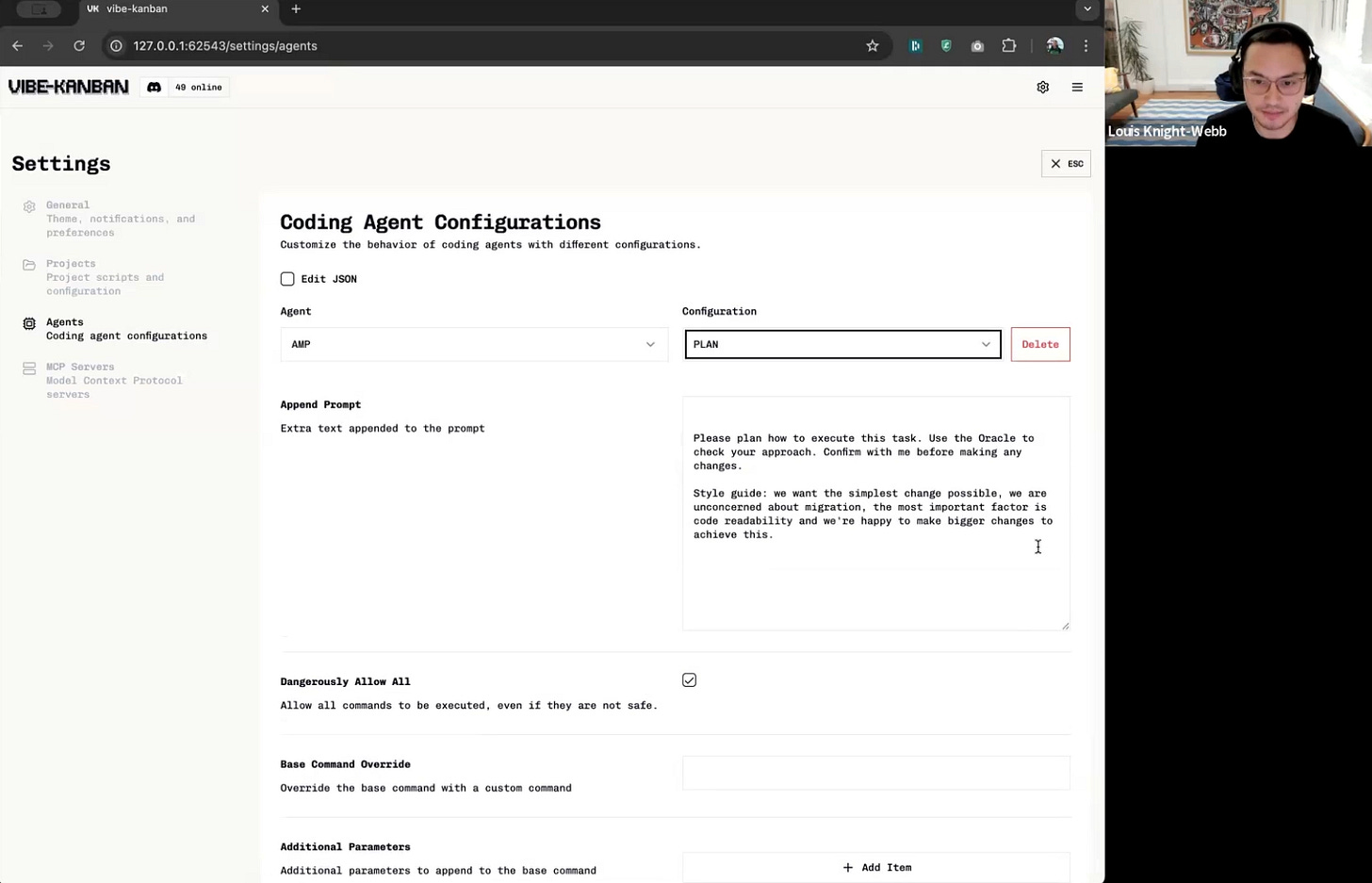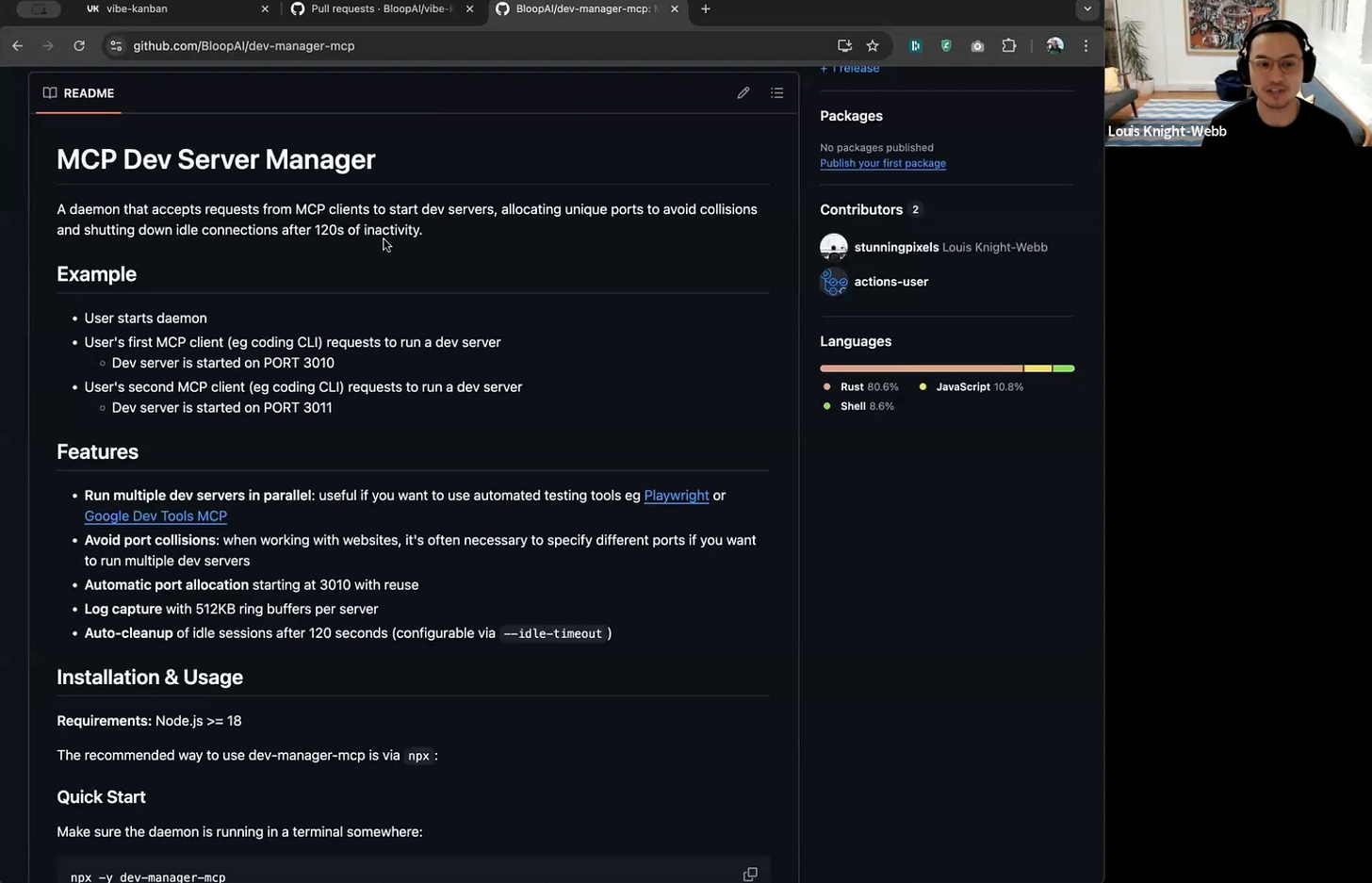Louis Knight-Webb on Vibe Kanban
Building the Future of Parallel AI Development
Introduction: Solving the Parallelization Problem
In a recent conversation at Elite AI-Assisted Coding, Eleanor hosted Louis Knight-Webb, CEO and co-founder of Bloop AI and developer of Vibe Kanban. The discussion covered how Vibe Kanban addresses a recurring challenge in AI-assisted development: managing multiple coding agents running in parallel.
As Eleanor explained in her introduction, there’s a fundamental trade-off in parallel AI development. Developers can either run multiple terminal sessions with separate work trees — which quickly becomes chaotic — or use cloud-based platforms where they sacrifice control and flexibility. Vibe Kanban rethinks this problem entirely:
“You can run all the same agents and all the different ones locally with all the control, with full configuration, but you get a web-based interface and also this very nice concept of managing parallel tasks in a way that makes sense.”
The Origin: Solving Personal Pain Points
Vibe Kanban emerged from practical necessity rather than strategic vision. Louis and his team were heavy users of Claude Code at the beginning of 2025, when it was virtually the only CLI coding agent available. The problems became apparent quickly:
“If you wanted to run more than one of them, you needed to open multiple terminals. But then if you wanted to run five of them, you needed to open five terminals. And very quickly you kind of find your brain gets fried from looking at green text and trying to remember, what did I run in this one?”
The team built Vibe Kanban initially to solve their own workflow problems. Within weeks of sharing it with other Y Combinator founders, they had daily users spending eight-plus hours in the tool. This adoption suggested that parallel AI development was a widespread need, not just a personal preference.
Strategic Positioning: Extrapolating the Trend
Beyond solving immediate problems, Louis identified a clear strategic direction by extrapolating current trends. The progression of AI coding assistance has moved from single-line completions in GitHub Copilot to entire functions in Cursor, to complete files, and now to multi-minute autonomous sessions:
“We’re no longer at 30 seconds, it’s like running for 5 minutes... if you kind of extrapolate from going from like 2 seconds to 30 seconds to 1 minute to 5 minutes, it seems kind of like we’re going to be running things for 10 or half an hour or an hour, you know, within 6 to 12 months reliably.”
This trajectory raises a question: What will humans do while these agents run? The answer, according to Louis, involves three activities: planning future work, reviewing completed work, and managing concurrent tasks. Vibe Kanban positions itself as the interface optimized for this emerging workflow.
The Centrality of Planning
Planning emerged as a central theme in the conversation. Louis emphasized that planning is “massively underrated” and insufficient attention to it leads to poor outcomes. He explained that the shift from interactive, in-the-loop coding to YOLO mode (auto-accepting all changes) requires stronger upfront planning:
“If you spend more time in the planning, you can displace time that otherwise would have been spent reviewing that code. You’re kind of shifting, you know, where you’re spending time from the end of the task to the start of the task.”
Louis demonstrated his planning workflow using a custom configuration with the Amp agent. His setup includes specific instructions to use a more powerful “Oracle” model, confirm the plan before making changes, and follow style guidelines that emphasize simplicity and code readability over backward compatibility.
He included an anti-laziness clause in his configuration:
“Claude loves to make very small changes, but you need to tell it, like, actually we value readability and we’re happy, you know, with you making a bigger change if that’s what it’s going to take to make the code readable.”
Iteration and Context Management
Louis’s approach to task execution involves frequent iteration rather than long conversations. He often makes multiple attempts at a task as his understanding evolves:
“My understanding of how the change should be implemented, you know, I only really understand that by the end of the task because, you know, AI is making the change and the chances are it’s modifying something that AI implemented in the first place.”
This iterative approach deliberately avoids long context windows. Louis noted that model accuracy degrades significantly with longer contexts, and developers who rely heavily on context compaction are “probably using these things wrong.” The models work better at 30,000 tokens than at 150,000 tokens, making fresh starts with refined plans more effective than extended conversations.
The Next Frontier: Automated Testing and QA
When asked about future directions, Louis identified automated testing and QA as the next breakthrough. Currently, most coding CLIs struggle with starting development servers, opening browsers, and actually testing their changes:
“I think the real breakthrough and why Claude Code is better than what came before Claude Code is because it can kind of test its own work, right? So it makes a change, and the very simple check it does is it runs the compiler and it checks, did the compiler pass or not?”
The next evolution involves agents that can properly QA their work — starting servers, creating user accounts, clicking through interfaces, and verifying functionality. This capability would enable agents to run for 10-15 minutes autonomously rather than just a few minutes.
To address immediate pain points, the team recently released the Dev Manager MCP, which solves the common problem of multiple dev servers colliding on ports. The MCP server automatically assigns free ports and kills idle servers after two minutes of inactivity.
Navigating the Multi-Agent Landscape
Supporting multiple coding agents has been a technical challenge. Vibe Kanban currently supports more coding CLIs than any other open-source project, requiring extensive normalization of different JSON formats and CLI outputs.
“You’ll find if you ever look at the source code for Vibe Kanban, it’s got like this ‘normalize’ function, which basically is just mapping JSON from all these different types to our special Vibe Kanban JSON.”
Usage is split roughly 50/50 between Claude Code and Codex, with another 15% distributed across other agents. Louis anticipates this balance will shift as new models launch, with developers switching to whichever CLI offers the best capabilities at any given moment.
The team is watching the Agentic Coding Protocol (ACP) initiative, promoted by Zed, which aims to standardize how different coding agents expose their APIs. Louis hopes to eventually merge Vibe Kanban’s normalization work with community standardization efforts.
Collaboration: The Emerging Challenge
While Vibe Kanban started as an individual developer tool, the team is actively exploring collaborative features. Louis noted that AI hasn’t created fundamentally new forms of collaboration, but it has created new problems that collaboration can solve:
“AI isn’t natively something that I feel anyway enables like new forms of collaboration, but it does create problems that can be solved with collaboration.”
Specifically, the increased code output — three to four times more lines per day than before AI — creates a review bottleneck. Additionally, faster task completion leads to more merge conflicts as team members more frequently edit the same files.
The team is exploring solutions like running planning in the cloud for every task to identify potential file conflicts, enabling more efficient scheduling of parallel work. A “Vibe Kanban Teams Edition” is expected within weeks.
Key Takeaways for Developers
The conversation revealed several practical insights for AI-assisted development:
Invest in Planning: Time spent on detailed planning displaces time spent reviewing flawed implementations. Fresh starts with refined plans beat long context windows.
Embrace Iteration: Understanding evolves through implementation. Multiple short attempts beat single long sessions.
Manage Context Length: Models degrade significantly at longer context windows. Keep conversations focused and start fresh when needed.
Think About Scale: As agents run longer, the human role shifts toward planning, reviewing, and orchestrating parallel work.
Prepare for Infrastructure Needs: Tools like dev server managers become essential as parallelization increases.
The session concluded with Louis emphasizing that Vibe Kanban and Bloop AI are hiring — looking for both backend and frontend engineers to help build the future of AI-assisted development. For developers managing multiple terminal sessions or working with cloud platforms, Vibe Kanban offers a third option that’s currently in production use.



